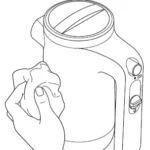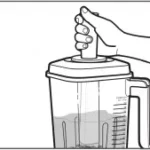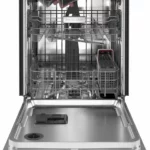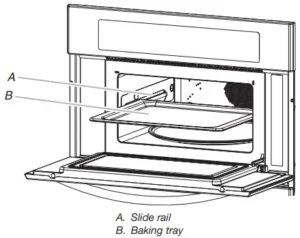
BUILT-IN MICROWAVE
COMBINATION OVENS –
MICROWAVE OVEN USER
INSTRUCTIONS
W10903390B
THANK YOU for purchasing this high-quality product. Register your built-in oven at www.kitchenaid.com. In Canada, register your microwave oven at www.kitchenaid.ca.
For future reference, please make a note of your product model and serial numbers. These can be found on the label located on the oven frame behind the top right side of the oven door.
Model Number _________________________________________
Serial Number __________________________________________
BUILT-IN OVEN SAFETY
Your safety and the safety of others are very important.
We have provided many important safety messages in this manual and on your appliance. Always read and obey all safety messages.
 his is the safety alert symbol.
his is the safety alert symbol.
This symbol alerts you to potential hazards that can kill or hurt you and others.
All safety messages will follow the safety alert symbol and either the word “DANGER” or “WARNING.”
These words mean:
 DANGER You can be killed or seriously injured if you don’t immediately follow instructions.
DANGER You can be killed or seriously injured if you don’t immediately follow instructions.
 WARNING You can be killed or seriously injured if you don’t follow instructions.
WARNING You can be killed or seriously injured if you don’t follow instructions.
All safety messages will tell you what the potential hazard is, tell you how to reduce the chance of injury, and tell you what can happen if the instructions are not followed.
IMPORTANT SAFETY INSTRUCTIONS
When using electrical appliances basic safety precautions should be followed, including the following:
WARNING: To reduce the risk of burns, electric shock, fire, injury to persons, or exposure to excessive microwave energy:
- Read all instructions before using the microwave oven.
- Read and follow the specific “PRECAUTIONS TO AVOID POSSIBLE EXPOSURE TO EXCESSIVE MICROWAVE ENERGY” found in this section.
- The microwave oven must be grounded. Connect only to properly grounded outlet. See “GROUNDING INSTRUCTIONS” found in this section.
- Install or locate the microwave oven only in accordance with the provided Installation Instructions.
- Some products such as whole eggs in the shell and sealed containers – for example, closed glass jars – may explode and should not be heated in the microwave oven.
- Use the microwave oven only for its intended use as described in this manual. Do not use corrosive chemicals or vapors in the microwave oven. This type of oven is specifically designed to heat, cook, or dry food. It is not designed for industrial or laboratory use.
- Oversized foods or oversized metal utensils should not be inserted in the microwave oven as they may create a fire or risk of electric shock.
- Do not clean with metal scouring pads. Pieces can burn off the pad and touch electrical parts involving a risk of electric shock.
- Do not store any materials, other than the manufacturer’s recommended accessories, in this oven when not in use.
- Do not operate the microwave oven if it has a damaged cord or plug, if it is not working properly, or if it has been damaged or dropped.
- Do not deep fry in the oven. Microwavable utensils are not suitable and it is difficult to maintain appropriate deep frying temperatures.
- Do not use paper products when the appliance is operated in the “PAN BROWN” mode.
- Do not cover racks or any other part of the oven with metal foil. This will cause overheating of the oven.
- As with any appliance, close supervision is necessary when used by children.
- The microwave oven should be serviced only by qualified service personnel. Contact the nearest authorized service company for examination, repair, or adjustment.
- Do not cover or block any openings on the microwave oven.
SAVE THESE INSTRUCTIONS
- Liquids, such as water, coffee, or tea are able to be overheated beyond the boiling point without appearing to be boiling. Visible bubbling or boiling when the container is removed from the microwave oven is not always present.
THIS COULD RESULT IN VERY HOT LIQUIDS SUDDENLY BOILING OVER WHEN THE CONTAINER IS DISTURBED OR A SPOON OR OTHER UTENSIL IS INSERTED INTO THE LIQUID.
To reduce the risk of injury to persons:
– Do not overheat the liquid.
– Stir the liquid both before and halfway through heating it.
– Do not use straight-sided containers with narrow necks.
– After heating, allow the container to stand in the microwave oven for a short time before removing the container.
– Use extreme care when inserting a spoon or other utensil into the container. - Liquids, such as water, coffee, or tea are able to be overheated beyond the boiling point without appearing to be boiling. Visible bubbling or boiling when the container is removed from the microwave oven is not always present.
THIS COULD RESULT IN VERY HOT LIQUIDS SUDDENLY BOILING OVER WHEN THE CONTAINER IS DISTURBED OR A SPOON OR OTHER UTENSIL IS INSERTED INTO THE LIQUID.
To reduce the risk of injury to persons:
– Do not overheat the liquid.
– Stir the liquid both before and halfway through heating it.
– Do not use straight-sided containers with narrow necks.
– After heating, allow the container to stand in the microwave oven for a short time before removing the container.
– Use extreme care when inserting a spoon or other utensil into the container.
PRECAUTIONS TO AVOID POSSIBLE EXPOSURE TO EXCESSIVE MICROWAVE ENERGY
(a) Do not attempt to operate this oven with the door open since an open-door operation can result in harmful exposure to microwave energy. It is important not to defeat or tamper with the safety interlocks.
(b) Do not place any object between the oven front face and the door or allow soil or cleaner residue to accumulate on sealing surfaces.
(c) Do not operate the oven if it is damaged. It is particularly important that the oven door close properly and that there is no damage to the:
(1) Door (bent),
(2) Hinges and latches (broken or loosened),
(3) Door seals and sealing surfaces.
(d) The oven should not be adjusted or repaired by anyone except properly qualified service personnel.
Electrical Requirements
Observe all governing codes and ordinances. The microwave oven is connected to both 120 V sides of the 208/240 V circuit required for electrical connections. If the incoming voltage to the microwave oven is less than 120 V, cooking times may be longer.
Have a qualified electrician check your electrical system.
This device complies with Part 18 of the FCC Rules.
GROUNDING INSTRUCTIONS
For a permanently connected microwave oven:
The microwave oven must be connected to a grounded, metallic, permanent wiring system, or an equipment grounding conductor should be run with the circuit conductors and connected to the equipment-grounding terminal or lead on the microwave oven.
SAVE THESE INSTRUCTIONS
PARTS AND FEATURES
This manual covers different models. The oven you have purchased may have some or all of the items listed. The locations and appearances of the features shown here may not match those of your model.
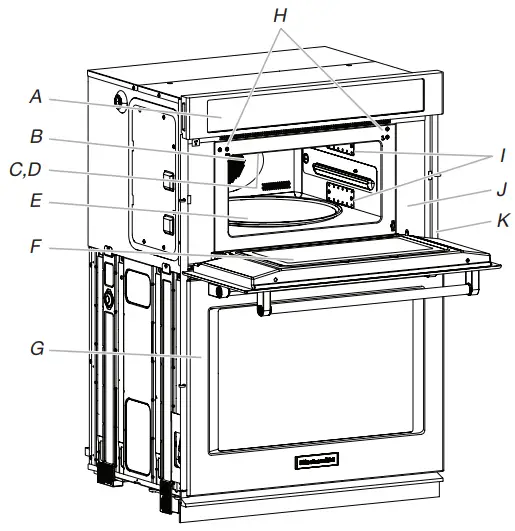
| A. Electronic oven control B. convection element and fan (hidden behind the back panel) C. Light (inaccessible, in-ceiling) D. Grill element (can be lowerE. Turntable F. Metal shielded window G. Lower oven (on combination models, see separate Use and Care Guide) |
H. Door safety lock system I. Dual microwave emission J. Cooking guide label K. Model and serial number plate (on the right mounting rail, single oven models) |
Parts and Features not shown
Steamer
Convection grid
Crisper pan and handle
Baking tray
Baking Tray
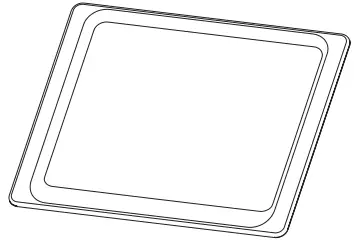
- The baking tray can be used only with convection cooking.
- To avoid damage to the microwave oven, do not use in combination with microwave cooking.
- The baking tray will become hot. Always use oven mitts or pot holders when handling.
- See the “Positioning Baking Tray” section before using it.
- See the “Assistance or Service” section to reorder.
Turntable
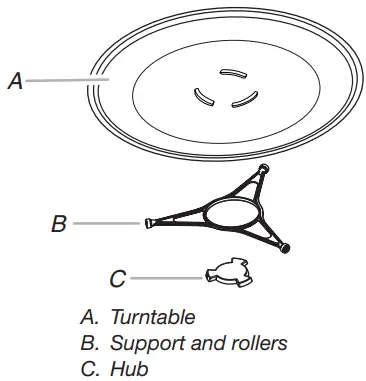
NOTE: By touching the Turntable On/Off keypad, it is possible to switch the turntable On and Off during some microwave cycles.
The turntable can be turned On or Off during the Manual Cook, Manual Reheat, Manual Defrost, Manual Steam Cook, and all Easy Convect™ cycles.
The turntable rotates in both directions to help cook food more evenly. Do not operate the microwave oven without having the turntable in place. See the “Assistance or Service” section to reorder any of the parts.
The raised, curved lines in the center of the turntable bottom fit between the 3 spokes of the hub. The hub turns the turntable during microwave oven use. The rollers on the support should fit inside the turntable bottom ridge.
Convection rack
The convection rack provides optimal heat circulation for convection cooking.
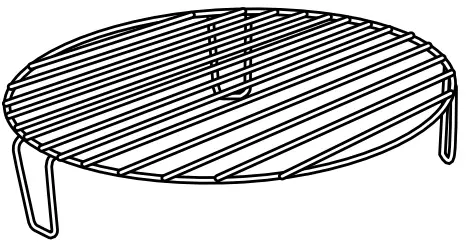
- The rack will become hot. Always use oven mitts or pot holders when handling.
- To avoid damage to the microwave oven, do not allow the rack to touch the inside cavity walls, ceiling or floor.
- Always use the turntable.
- To avoid damage to the microwave oven, do not store the rack in the microwave oven.
- Two-level cooking is not recommended.
- For best results, do not place popcorn bags on the rack.
- The rack is designed specifically for this microwave oven. For best cooking results, do not attempt to use any other rack in this microwave oven.
- See the “Assistance or Service” section to reorder.
Crisper Pan and Handle
 The crisper pan, with its nonstick surface and detachable handle, has been specifically designed for microwave use and is ideal for pan-frying (pan-browning) foods in the microwave oven.
The crisper pan, with its nonstick surface and detachable handle, has been specifically designed for microwave use and is ideal for pan-frying (pan-browning) foods in the microwave oven.
- The crisper pan will become hot. Always use the handle and oven mitts or pot holders when handling. Place the gripping end on the edge of the pan, squeeze the handle, and lift the pan.
- To avoid damage to the microwave oven, do not allow the crisper pan or handle to touch the inside cavity walls, ceiling, or floor.
- Do not place a crisper pan on the convection grid. Always use the turntable as a support for the crisper pan.
- To avoid damage to the microwave oven, do not use another metal object with the crisper pan.
- To avoid damage, do not place a hot crisper pan directly on heat-sensitive surfaces.
- The crisper pan is designed specifically for this microwave ven. Do not use it in any other oven.
- Use only wooden or plastic cooking utensils to help avoid scratches.
- See the “Assistance or Service” section to reorder.
KitchenAid™ Steamer Vessel
Use the Steamer Vessel with the Steam Cook feature to steam foods.
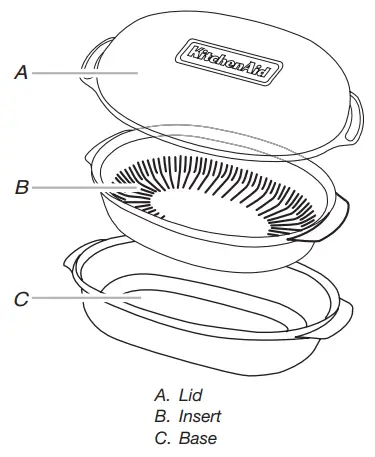
- The steamer vessel will become hot. Always use oven mitts or pot holders when handling.
- The steamer vessel is designed to be used only in the microwave oven. To avoid damaging steamer vessel, do not use in a conventional- or combination-type oven, with any other convection or crisp function, or on electric or gas burners.
- Do not use plastic wrap or aluminum foil when covering the food.
- Always place the steamer vessel on the glass turntable. Check that the turntable turns freely before starting the microwave oven.
- Do not remove the lid while the base is inside the microwave oven, as the rush of steam will disrupt the sensor settings.
- To avoid scratching, use plastic utensils.
- Do not overfill with water. See the steam chart in the “Steam Cooking” section for the amount of water recommended. Lid: Always use the lid when steaming. Place directly over the insert and base or just the base.
Insert: Use when steam cooking to keep foods such as fish and vegetables out of the water. Place insert with food directly over the base. Do not use when simmering.
Base: For steam cooking, place water in the base. For simmering foods such as rice, potatoes, pasta, and vegetables, place food and water/liquid in the base.
See the “Assistance or Service” section to order replacements.
See the “General Cleaning” section for instructions on cleaning.
Control Panel
This manual covers several models. Your model may have some or all of the items listed. Refer to this manual or the Frequently Asked Questions (FAQs) section of our website at www.kitchenaid.com for more detailed instructions. In Canada, refer to the Service and Support section at www.kitchenaid.ca.

| Keypad | Feature | Instructions |
| OVEN LIGHT | Oven cavity light | The Oven Light keypad controls the oven light. While the oven door is closed, touch OVEN LIGHT to turn the oven light on and off. When the oven door is opened, the oven light will automatically come on. |
| START | Function start | The Start keypad begins any oven function. If Start is not touched within 5 minutes after touching a keypad, the function is canceled and the time of day is displayed. |
| MICROWAVE ADD 30 SEC |
Add 30Seconds | The Add 30 Sec keypad will start 30 seconds of cook time at 100% power when The microwave oven is off. When a manual cook cycle is running, Add 30 Sec will add 30 seconds of cook time to the current cycle. Multiple minutes can be added by repeatedly touching Add 30 Sec. |
| CANCEL MICROWAVE CANCEL LOWER |
Functioncancel | The Cancel keypads stop any function for the appropriate oven except the Clock and Timer. |
| BACK | Go back a screen | The Back keypad will cancel current changes and go back one screen every time it is pressed. |
| KITCHEN TIMER | Kitchen timer | The Kitchen Timer keypad will set a timer that is independent of oven functions. The kitchen timer can be set in hours, minutes, and seconds, up to 99 hours. NOTE: The kitchen timer does not start or stop the oven. |
| RECENTLY USED | Recall function | The Recently Used keypad allows you to quickly select a recent cycle. 1. Touch RECENTLY USED. 2. Select the desired oven cavity. 3. Select the desired recent cooking mode from the available list. NOTE: If no cooking modes have been used, there will not be any options. |
| REMOTE ENABLE | Enable RemoteApp control | Press REMOTE ENABLE to enable the ability to use the KitchenAid® app. If Wi-Fi is not already enabled, the oven will attempt to connect to a local network. NOTE: Remote Enable only works for the lower oven. It does not control the microwave oven. |
| SELF CLEAN | Self-Cleaning | Touch SELF CLEAN. Follow the on-screen prompts to set the self-cleaning cycle. See the “Self-Cleaning Cycle” section for more information. NOTE: Self-Clean only works for the lower oven. It does not clean the microwave oven. |
Welcome Guide
The Welcome Guide allows you to set up your new microwave oven. This appears on your display the first time the microwave oven is powered up or after resetting the oven to factory defaults.
After every selection, a tone will sound. Touch BACK at any time to return to the previous screen.
- Select your language and touch OK.
- To connect the oven to the mobile app, touch YES
OR
touch NOT NOW to skip this step and complete setup. Go to Step 7. - Select CONNECT to automatically connect the oven to the mobile app. Download the KitchenAid app, signup, and select “Add Appliance” in the app. Follow the instructions in the app to scan the QR code from the appliance screen.
- To manually connect the oven to the KitchenAid app, touch FIND NETWORK. Select your home network from the list, touch ADD A NETWORK to manually enter your home network, or touch CONNECT WITH WPS to connect to your network via WPS.
If prompted, enter your Wi-Fi password. - A message will appear when the microwave oven has successfully connected to the Wi-Fi network. Touch OK.
- Touch OFF and then touch OK to set the time and date manually
OR
touch ON and then touch OK to set the clock automatically via the Wi-Fi network. Go to Step 9. - Touch the number keypads to set the time of day. Select AM, PM, or 24-HOUR. Touch OK.
- Select if Daylight Savings Time is active. Touch OK.
- Select the format for displaying the date. Touch OK.
- Touch the number keypads to set the current date. Touch OK.
- Select if you want to show the clock when the oven is idle.
- Touch DONE.
Display Screens
Clock Screen
The Clock screen displays the time and date when the microwave oven is not in use.

A. Status icons
B. Status bar
C. Kitchen timer
D. Control Lock
E. Home menu
F. Settings menu
Control Lock
Touch and hold to lock the control. Only the Control Lock icon will respond when the control is locked.
Home Menu
Touch to set a microwave oven function or access Results mode.
Kitchen Timer
Shows the current kitchen timer. Touch to set or modify the kitchen timer.
Settings Menu
Touch to access microwave oven settings and information.
Status Bar
Displays current microwave oven status, such as Demo mode or locked.
Status Icons![]() Indicates a problem with the wireless connection.
Indicates a problem with the wireless connection.![]() Indicates Remote Enable is active.
Indicates Remote Enable is active.![]() Indicates +Powered Attachments are connected to the oven.
Indicates +Powered Attachments are connected to the oven.
Function Set Screen
After selecting a microwave oven function, the Function Set screens have a variety of options to customize the cycle. Not all options are available on all microwave oven functions. Touch the option in the menu on the left to change the setting.
A. Function
B. Time
C. Power level
D. Turntable
Not shown:
Sensor
Food/Option
Amount
Doneness
Microwave oven temperature set
Preheat
Favorite
Information
Function
Shows the current microwave function and selected oven.
Sensor
Indicates automatic cooking time/power level: no setting needed, just touch START to begin.
Food/Option
Touch to select the type of food being cooked.
Amount
Touch to set the amount of food being cooked. Units will change based on the type of food selected.
Doneness
Touch to set the doneness level of the food being cooked.
Microwave oven temperature set
Touch to set the microwave oven temperature. The allowed range will be displayed.
Time
Touch to set a length of time for the function to run.
Power level
Touch to set the microwave power level.
Turntable
Touch to set the turntable to on or off.
Preheat
Touch to set preheating the crisper pan or not.
Favorite (optional)
Touch to set the selected settings as a Favorite function. Touch again to unfavorite. Favorite microwave settings can be accessed from the Home menu.
Information
Touch to get specific information about the selected microwave function, how it works, what it is best used for, and how best to position racks and accessories.
Status Screen
While the microwave oven is in use, the display will show a timeline with information about the current microwave oven function(s). If one of the ovens is not in use, a button to use that oven will appear.
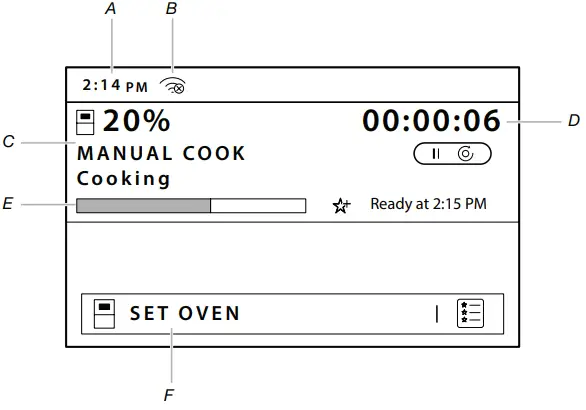
| A. Time of day B. Wireless strength C. Microwave oven function information |
D. Microwave oven timer E. Microwave oven timeline F. Lower oven settings |
Time of day
Shows the current time of day.
Wireless strength
Shows the current Wi-Fi status and strength.
Microwave oven function information
Shows the current microwave oven function settings for the indicated cavity.
Microwave oven timer
Shows the remaining cook time (if set).
Kitchen timer
Touch to set a kitchen timer or modify an existing one.
Microwave oven timeline
Shows where the microwave oven is in the cooking process and when it will finish. The time in the middle of the screen is the time of day.
Lower oven settings
Touch to use the lower oven. See the Lower Oven User Instructions.
Cooking Modes
The microwave oven has a variety of cooking modes to achieve the best results every time. The cooking modes can be accessed by touching the Home icon and then selecting the desired oven or a previously saved Favorite recipe.
Microwave Oven
| Cooking Mode | Best for |
| Manual Cook | Foods that start out wet or not solid (like batter), then firm up and gain structure or rise as they cook (like cakes or casseroles) |
| Popcorn | Bags of microwave popcorn |
| Defrost | Foods that need to be thawed before cooking |
| Reheat | Foods that have been previously cooked |
| Soften | Softening foods like butter or ice cream |
| Melt | Melting foods like chocolate or cheese |
| Convect Bake | Foods with flaky and dry crusts with moist interiors (like pastries, pies, or bread) |
| Steam | Steaming foods like vegetables or seafood |
| Crisp | Crisping or grilling foods like fries or pizza |
Kitchen Timer
The Kitchen Timer keypad will set a timer that is independent of microwave oven functions. The kitchen timer can be set in hours, minutes, and seconds, up to 99 hours.
NOTE: The kitchen timer does not start or stop the microwave oven.
- Touch KITCHEN TIMER.
- Touch HR: MIN or MIN: SEC.
- Touch the number keypads to set the length of time.
NOTE: Touching HR: MIN or MIN: SEC, after the time has been - entered, will clear the timer.
- Touch the Start button on the display to start the kitchen timer.
- To change the kitchen timer while it is running, touch the KITCHEN TIMER, touch the number keypads to set the new length of
time, and then touch UPDATE. - A sound will play when the set time ends, and a drop-down notification will appear. Touch OK to dismiss the notification.
- Touch BACK while setting the kitchen timer to cancel the kitchen timer. To cancel a running timer, touch KITCHEN TIMER and then the Cancel button on the display. If a Cancel keypad is touched, the respective oven will turn off.
Tones/Sounds
Tones are audible signals, indicating the following:
- Valid keypad touch
- The function has been entered.
- The oven is preheated.
- Invalid keypad touch
- End of a cooking cycle
- When the timer reaches zero Includes using the kitchen timer for functions other than cooking.
- First oven element activation in a cooking mode
- +Powered attachments connected
- +Powered attachments disconnected
- Control is locked
- Control is unlocked
Control Lock
 The Control Lock shuts down the control panel keypads to avoid unintended use of the microwave oven. The Control Lock will remain set after a power failure if it was set before the power failure occurs. When the control is locked, only the Control Lock and Kitchen Timer keypads will function.
The Control Lock shuts down the control panel keypads to avoid unintended use of the microwave oven. The Control Lock will remain set after a power failure if it was set before the power failure occurs. When the control is locked, only the Control Lock and Kitchen Timer keypads will function.
The Control Lock is preset unlocked but can be locked.
To Activate the Control Lock:
- Touch and hold the Control Lock icon.
- A countdown will appear in the gray Status bar at the top of the screen. The Control Lock icon will turn red and the Status bar will display “LOCKED” when the control is locked.
To Deactivate the Control Lock:
- Touch and hold the Control Lock icon.
- A countdown will appear in the gray Status bar at the top of the screen. The Control Lock icon will no longer be red and the Status bar will be blank when the control is unlocked.
Settings

The Settings icon allows you access to functions and customization options for your oven. These options allow you to set the clock, change the microwave oven temperature between Fahrenheit and Celsius, turn the audible signals and prompts on and off, adjust the oven calibration, change the language, and more. Many of these options are set during the Welcome Guide.
The Sabbath mode is also set using the Settings menu.
| Setting | Available Selections |
| Date & Time | ■ Auto (Off/On)* ■ Time (AM/PM/24-Hour)* ■ Daylight Savings (Off/On)* ■ Date Format (MM/DD/YYYY, DD/MM/ YYYY, YYYY/MM/DD)* ■ See Date* ■ Show Clock (No & Turn Off Screen/Yes & Dim Screen)* |
| Background | ■ Set Background Picture |
| Wi-Fi | ■ Network* ■ SAID/MAC Address ■ Wireless Icon (Show [default]/Hide) ■ Wireless (On/Off)* |
| Sounds | ■ Timers (High [default]/Medium/Low/Off) ■ Notifications (High [default]/Medium/Low/ Off) ■ Accessory In/Out (High/Medium [default]/ Low/Off) ■ Keypress (High [default]/Medium/Low/Off) ■ Mute (Sounds On [default]/Sounds Off) |
| Temperature | ■ Temperature (Fahrenheit [default]/Celsius) |
| Display | ■ Brightness (Low/Medium/High/Maximum [default]) |
| Language | ■ Language (English/Français)* |
| Attachment Registration |
■ View/Register +Powered Attachments |
| Manage Favorites |
■ Clear All Favorites |
| Calibrate | ■ Instructions ■ Lower Oven (0/+10°F/+20°F/+30°F/-10°F/-20°F/-30°F) (0/+6°C/+12°C/+18°C/-6°C/-12°C/-18°C) |
| Sabbath Mode | ■ Disables all oven functions, lights, clock, and messages. Press any Cancel keypadto end Sabbath Mode. |
| Sabbath Bake | ■ Instructions ■ Upper/Single Oven Temperature ■ Upper/Single Oven Timer ■ Lower Oven Temperature ■ Lower Oven Timer ■ Confirm (No/Yes) |
| Demo | ■ Demo (Off [default]/On) |
| General | ■ About (Model/Serial numbers, Software Version, SAID/MAC Address) ■ Update (Software update) |
| Factory Reset | ■ Reset |
BUILT-IN MICROWAVE OVEN USE
A magnetron in the oven produces microwaves that reflect off the metal floor, walls, and ceiling and pass through the turntable and appropriate cookware to the food. Microwaves are attracted to and absorbed by fat, sugar, and water molecules in the food, causing them to move, producing friction and heat which cooks the food.
- To avoid damage to the microwave oven, do not lean on or allow children to swing on the microwave oven door.
- To avoid damage to the microwave oven, do not operate the microwave oven when it is empty.
- The turntable must be in place and correct side up when the microwave oven is in use. Do not use if the turntable is chipped or broken. See the “Assistance or Service” section to reorder.
- Baby bottles and baby food jars should not be heated in a microwave oven.
- Clothes, flowers, fruit, herbs, wood, gourds, and paper, including brown paper bags and newspaper, should not be dried in a microwave oven.
- Paraffin wax will not melt in the microwave oven because it does not absorb microwaves.
- Use oven mitts or pot holders when removing containers from the microwave oven.
- Do not overcook potatoes. At the end of the recommended cook time, potatoes should be slightly firm. Let potatoes stand for 5 minutes. They will finish cooking while standing.
- Do not cook or reheat whole eggs inside the shell. Steam buildup in whole eggs may cause them to burst. Cover poached eggs and allow a standing time.
Food Characteristics
When microwave cooking, the amount, size and shape, starting temperature, composition, and density of the food affect cooking results.
Amount of Food
The more food heated at once, the longer the cooking time needed.
Check for doneness and add small increments of time if necessary.
Size and Shape
Smaller pieces of food will cook more quickly than larger pieces, and uniformly shaped foods cook more evenly than irregularly shaped food.
Starting Temperature
Room temperature foods will heat faster than refrigerated foods, and refrigerated foods will heat faster than frozen foods.
Composition and Density
Foods high in fat and sugar will reach a higher temperature and will heat faster than other foods. Heavy, dense foods, such as meat and potatoes, require a longer cook time than the same size of a light, porous food, such as cake.
Cooking Guidelines
Covering
Covering food helps retain moisture, shorten cook time, and reduce spattering. Use the lid supplied with cookware. If a lid is not available, wax paper, paper towels, or plastic wrap approved for microwave ovens may be used. Plastic wrap should be turned back at one corner to provide an opening to vent steam.
Condensation on the door and cavity surfaces is normal during heavy cooking.
Stirring and Turning
Stirring and turning redistribute heat evenly to avoid overcooking the outer edges of food. Stir from outside to the center. If possible,
turn food over from bottom to top.
Arranging
If heating irregularly shaped or different sized foods, arrange the thinner parts and smaller sized items toward the center. If cooking
several items of the same size and shape, place them in a ring pattern, leaving the center of the ring empty.
Piercing
Before heating, use a fork or small knife to pierce or prick foods that have a skin or membrane, such as potatoes, egg yolks, chicken livers, hot dogs, and sausage. Prick in several places to allow steam to vent.
Shielding
Use small, flat pieces of aluminum foil to shield the thin pieces of irregularly shaped foods, bones, and foods such as chicken wings, leg tips, and fishtails. See the “Aluminum Foil and Metal” section first.
Standing Time
Food will continue to cook by the natural conduction of heat even after the microwave cooking cycle ends. The length of standing time depends on the volume and density of the food.
Turntable On/Off
For best performance, the turntable should be on during microwave cooking.
If using oversized cookware that does not turn freely on the microwave turntable, turn the turntable off. To turn off the turntable when setting a microwave function, touch TURNTABLE and then OFF. When cooking with the turntable off, food should be turned halfway through the cooking process.
NOTE: The turntable cannot be turned off during any auto cooking cycle.
Cookware and Dinnerware
Cookware and dinnerware must fit on the turntable. Always use oven mitts or pot holders when handling because any dish may become hot from heat transferred from the food. Do not use cookware and dinnerware with gold or silver trim. Use the following chart as a guide, then test before using.
| Maternal | “Recommendations |
| Aluminum Foil, Metal | See the “Aluminum Foil and Metal” section. |
| Browning Dish | The bottom must be at least 3/16′ (5 mm) above the turntable. Follow manufacturer’s recommendations. |
| Ceramic Glass, Glass | Acceptable for use. |
| China, Earthenware | Follow manufacturer’s recommendations. |
| Melamine | Follow manufacturer’s recommendations. |
| Paper: Towels, Dinnerware, Napkins | Use non-recycled and those approved by the manufacturer for microwave oven use. |
| Plastic: Wraps, Bags, Covers, Dinnerware, Containers | Use those approved by the manufacturer for microwave oven use. |
| Pottery and Clay | Follow manufacturer’s recommendations. |
| Silicone Bakeware | Follow manufacturer’s recommendations. |
| Straw, Wicker, Wooden Containers |
Do not use in a microwave oven. |
| Styrofoam®t | Do not use in a microwave oven. |
| Wax Paper | Acceptable for use. |
To Test Cookware or Dinnerware for Microwave Use:
- Place cookware or dinnerware in the microwave oven with 1 cup (250 mL) of water beside it.
- Cook at 100% cooking power for 1 minute.
Do not use cookware or dinnerware if it becomes hot and the water stays cool.
Aluminum Foil and Metal
Always use oven mitts or pot holders when removing dishes from the microwave oven.
Aluminum foil and some metal can be used in the microwave oven. If not used properly, arcing (a blue flash of light) can occur and cause damage to the microwave oven.
OK for Use
Racks and bakeware supplied with the microwave oven (on some models), aluminum foil for shielding, and approved meat thermometers may be used with the following guidelines:
- To avoid damage to the microwave oven, do not allow
aluminum foil or metal to touch the inside cavity walls, ceiling
or floor. - Always use the turntable.
- To avoid damage to the microwave oven, do not allow contact with another metal object during microwave cooking.
Do Not Use
Metal cookware and bakeware, gold, silver, pewter, non-approved meat thermometers, skewers, twist ties, foil liners such as sandwich wrappers, staples, and objects with gold or silver trim or a metallic glaze should not be used in the microwave oven.
Positioning Baking Tray
The baking tray can only be used with convection cooking and broiling (on some models). To avoid damage to the microwave oven, do not use the baking tray in combination with microwave cooking.
Place the baking tray on slide rails as shown below. Push in the baking tray to stop position. Check that the baking tray is level.
For best cooking results, use the baking tray only in the recommended position.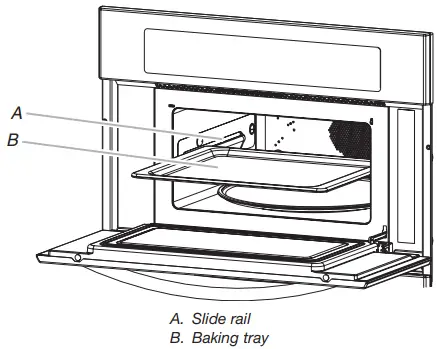
†® Styrofoam is a registered trademark of the Dow Chemical Company.
Microwave Cooking Power
Many recipes for microwave cooking specify which cooking power to use by percent, name, or number. For example, 70%=Medium-High=7.
Use the following chart as a general guide for the suggested cooking power of specific foods.
The power level cannot be changed in Sensor cooking modes.
MICROWAVE COOKING POWER CHART
| Percent/ Name | Number | Use |
| 100%, High (default setting) | 10 | Quick heating convenience foods and foods with high water content, such as soups, beverages, and most vegetables. |
| 90% | 9 | Cooking small, tender pieces of meat, ground meat, poultry pieces, and fish fillets. Heating cream soups. |
| 80% | 8 | Heating rice, pasta, or casseroles. Cooking and heating foods that need a cook power lower than high. For example, whole fish and meatloaf. |
| 70%, Medium- High | 7 | Reheating a single serving of food. |
| 60% | 6 | Cooking sensitive foods such as cheese and egg dishes, pudding, and custards. Cooking non-stirrable casseroles, such as lasagna. |
| 50%, Medium | 5 | Cooking ham, whole poultry, and pot roasts. Simmering stews. |
| 40% | 4 | Melting chocolate. Heating bread, rolls, and pastries. |
| 30%, Medium- Low, Defrost | 3 | Defrosting bread, fish, meats, poultry, and precooked foods. |
| 20% | 2 | Softening butter, cheese, and ice cream. |
| 10%, Low | 1 | Taking chill out of fruit. |
Sensor Cook
The Sensor is used in auto cooking modes.
During the Sensor Cook function, a sensor automatically adjusts the cooking time and power level.
The timeline will show “SENSING” and then the time countdown once the sensor identifies the cooking duration.
If the microwave oven door is opened during a sensor function, the microwave oven will turn off and any additional operations will
be canceled.
For best cooking performance:
Before using a sensor cook function, make sure power has been supplied to the microwave oven for at least 2 minutes, the room temperature is not above 95°F (35°C), and the outside of the cooking container and the microwave oven cavity is dry.
Popcorn
- Do not use regular paper bags or glassware.
- Pop only one package of popcorn at a time.
- Follow manufacturer’s instructions when using a microwave popcorn popper.
- Listen for popping to slow to one pop every 1 or 2 seconds, and then stop the cycle. Do not repop unpopped kernels.
- For best results, use fresh bags of popcorn.
- Cooking results may vary by brand and fat content.
- Recommended bag sizes are 3.5 oz, 3.0 oz, and 1.75 oz.
NOTE: Follow the instructions provided by the microwave popcorn manufacturer.
Defrost
Times and cooking powers have been preset for defrosting a number of food types.
Manual Defrost requires that a cook time and power level be entered if using other than 30% cook power.
- For optimal results, food should be 0°F (-18°C) or colder when defrosting.
- Unwrap foods and remove lids (from fruit juice) before defrosting.
- Shallow packages will defrost more quickly than deep blocks.
- Separate food pieces as soon as possible during or at the end of the cycle for more even defrosting.
- Foods left outside the freezer for more than 20 minutes or frozen ready-made food should not be defrosted using an automatic Defrost setting but should be defrosted manually.
- Use small pieces of aluminum foil to shield parts of food such as chicken wings, leg tips, and fishtails. See the “Aluminum
Foil and Metal” section first.
Use the following chart as a guide when defrosting meat, poultry, fish, bread, or juice.
DEFROST PREPARATION CHART
| MEAT | |
| Beef: ground, steaks, roast, stew |
The narrow or fatty areas of irregular-shaped cuts should be shielded with foil before defrosting. Do not defrost less than 1/4 lb (113 g) or two 4 oz (113 g) patties. Place all meats in a microwave-safe baking dish. |
| Lamb: stew and chops | |
| Pork: chops, ribs, roasts, sausage |
|
| POULTRY | |
| Chicken: whole and cut up |
Place in a microwave-safe baking dish, chicken breast-side up. Remove giblets from the whole chicken. |
| Cornish hens | |
| Turkey: breast | |
| FISH | |
| Fillets, steaks, whole, shellfish |
Place in a microwave-safe baking dish. |
| BREAD | |
| Loaves, muffins, biscuits, slices |
Place in a microwave-safe baking dish. |
| JUICE | |
| Frozen juice or juice concentrate |
Remove from any metal containers. Place in a microwave-safe baking dish. |
Reheat
Times and cooking powers have been preset for reheating a number of food types.
Manual Reheat requires that a cook time and a power level be entered if using other than 70% cook power.
Use the following chart as a guide.
REHEAT CHART
| Food | Preparation |
| Meal | Place food on the plate. Cover with plastic wrap and vent. Let stand 2-3 minutes after reheating. |
| Beverage | Do not cover. |
| Casserole | Place in a microwave-safe container. Cover with plastic wrap and vent. Stir and let stand 2-3 minutes after reheating. |
| Pizza | Place on a paper towel-lined microwave-safe plate. |
| Soup | Place in a microwave-safe container. Cover with plastic wrap and vent. Stir and let stand 2-3 minutes after reheating. |
| Sauce | Place in a microwave-safe container. Cover with plastic wrap and vent. Stir and let stand 2-3 minutes after reheating. |
| Manual | Default power level 70% |
Soften/Melt
Soften and Melt functions may be used to soften or melt your food. Times and cooking powers have been preset for a number of food types. Use the following chart as a guide.
| Food | Preparation |
| Butter | Unwrap and place in a microwave-safe container. |
| Margarine | Unwrap and place in a microwave-safe container. |
| Ice Cream | Place in a microwave-safe container. |
| Chocolate | Cut squares into small pieces or use chips. Place in a microwave-safe container. |
| Cream cheese | Unwrap and place in a microwave-safe container. |
| Cheese | Cut into small pieces and place in a microwave-safe container. |
| Marshmallows | Place in a microwave-safe container. |
EasyConvect™ Conversion

A. Broil element
B. convection fan
C. Convection element
D. Convection grid
Convection cooking uses the convection element, the broil element, and the fan. Hot air is circulated throughout the oven cavity by the fan. The constantly moving air surrounds the food to heat the outer portion quickly.
- The convect function may be used to cook small amounts of food on a single rack.
- Always use the convection grid placed on the turntable or baking tray.
- Do not cover turntable or convection grid or baking tray with aluminum foil.
- Do not use light plastic containers, plastic wrap, or paper products. All heatproof cookware or metal utensils can be used in convection cooking. Round pizza pans are excellent for convection cooking.
- Use convection cooking for items such as shuffles, bread, cookies, angel food cakes, pizza, and most meats and fish.
- All EasyConvect™ functions require preheating before use.
Place food in the microwave oven after preheating is complete.
EasyConvect™ Conversion is a function that converts a standard thermal bake cook time and temperature into an ideal cook time and temperature for convection cooking after the oven has preheated.
Convection temperatures and times differ from those of standard cooking. The oven can automatically reduce standard recipe temperatures and times for convection cooking.
When selecting a convection cooking mode, the option to optimize the recipe for convection will be available.
To have the oven automatically adjust the set time and/or temperature for better convection cooking results, select YES. The oven will automatically adjust for convection cooking.
To manually enter the set time and temperature one time, select NO. The option to optimize the recipe will be available the next time a convection cooking mode is selected.
To never have the oven optimize the recipe, select NO, DON’T ASK AGAIN. The oven will not change the set time or temperature
and will not ask again.
This option can be reset from the Settings menu.
The conversion may not be exact because foods are grouped in general categories. Use the most similar food option if your exact food is not available.
Steam Cooking
Steam Cook is a sensor cooking function that uses microwaves to steam food. Always use a steamer vessel. See the “KitchenAid™ Steamer Vessel” section before using. Use Steam Cook for foods such as vegetables, fish, and potatoes.
- Times and cooking powers have been preset for steaming a number of food types.
- Manual Steam Cook requires that a cook time be entered.
- It is recommended to add 1/2 cup (125 mL) of water to Steamer Vessel before steaming.
Crisp
The Crisp feature uses the broil element and microwaves to crisp and brown foods. Crisp can be used to sauté meats and vegetables, pan-fry bacon and eggs, and to crisp and brown pizza and French fries. Always use the crisper pan. See the “Crisper Pan and Handle” section before using.
- The crisper pan will become very hot. Use oven mitts or detachable handles to grasp and remove the pan from the oven.
- Do not place hot crisper pan directly on heat-sensitive surfaces. Damage may occur.
- Do not use plastic utensils on the crisper pan, as it becomes very hot quickly and could melt the utensils.
- Do not use metal utensils, as they can scratch the pan.
- Do not use the crisper pan in any other microwave oven or in a standard thermal oven.
- Do not place the crisper pan on the convection rack or the baking tray. Always use the turntable as a support for the pan.
Before Crisping, brush the crisper pan with 1/2 tsp (3 mL) of oil or spray with nonstick cooking spray. For best results, the crisper pan should be preheated for 3 minutes. Arrange food on the crisper pan, and place pan on turntable.
Use the following chart as a guide.
CRISPING CHART
| Food | Cook Time(Minutes)* | Preparation |
| Bacon, 4 strips | Side 1: 3:00Side 2: 1:45 | Place in crisper pan in a single layer |
| Frozen French fries,2 servings | Side 1: 5:00Side 2: 2:00 | Place in crisper pan in a single layer |
| Boneless chicken breasts, 2 pieces |
Side 1: 4:00 Side 2: 3:00 |
5-6 oz (142-170 g) each |
| Hamburger patties, 2 | Side 1: 3:30 Side 2: 2:00 |
4 oz (113 g) each, 1/2″ (1.3 cm) thick |
| Frozen thin crust pizza | 8:00-9:00 |
*Times are approximate and may be adjusted for individual tastes.
BUILT-IN MICROWAVE OVEN CARE
General Cleaning
IMPORTANT: Before cleaning, make sure all controls are off and the microwave oven is cool. Always follow label instructions on learning products.
Soap, water, and a soft cloth or sponge are suggested first unless otherwise noted.
STAINLESS STEEL (on some models)
NOTE: To avoid damage to stainless steel surfaces, do not use soap-filled scouring pads, abrasive cleaners, cooktop polishing creme, steel-wool pads, gritty washcloths, or abrasive paper towels. Damage may occur to stainless steel surfaces, even with one-time or limited use.
Rub in direction of grain to avoid damaging.
Cleaning Method:
- Affresh® Stainless Steel Cleaner Part Number W10355016 (not included):
See the “Assistance or Service” section to order. - Vinegar for hard water spots.
MICROWAVE OVEN DOOR EXTERIOR
Cleaning Method:
- Glass cleaner and a soft cloth or sponge:
Apply glass cleaner to soft cloth or sponge, not directly on panel. - Affresh® Kitchen Appliance Cleaner Part Number W10355010(not included):
See the “Assistance or Service” section to order.
MICROWAVE OVEN CAVITY
To avoid damage to the microwave oven cavity, do not use soap-filled scouring pads, abrasive cleaners, steel-wool pads, gritty washcloths, or some paper towels.
On stainless steel models, rub in direction of the grain to avoid damage.
The area where the oven door and frame touch when closed should be kept clean.
Cleaning Method:
Average soil
- Mild, nonabrasive soaps and detergents:
Rinse with clean water and dry with a soft, lint-free cloth.
Heavy soil
- Mild, nonabrasive soaps and detergents:
Heat 1 cup (250 mL) of water for 2 to 5 minutes in oven.
Steam will soften soil. Rinse with clean water and dry with soft, lint-free cloth.
Odors
- Lemon juice or vinegar:
Heat 1 cup (250 mL) of water with 1 tbs (15 mL) of either lemon juice or vinegar for 2 to 5 minutes in oven.
MICROWAVE OVEN CEILING
The broil element does not need cleaning since the intense heat will burn off any food spatters. However, the ceiling above the broil element may need regular cleaning.
Cleaning Method:
- Warm water, mild detergent and a sponge.
To clean:
- Push the fastening thread gently towards the back of the ceiling and then lower it to release the broil element.
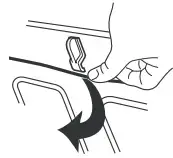
- Lower the front of the broil element to access the ceiling for cleaning.
- Raise broil element back up and return the fastening thread back to its original location.

Always return the broil element to the cooking position after cleaning.
TURNTABLE
Replace turntable immediately after cleaning. Do not operate the microwave oven without the turntable in place.
Cleaning Method:
- Mild cleanser and scouring pad
- Dishwasher
RACK
- Steel-wool pad
- Dishwasher
CRISPER PAN
To avoid damage to the crisper pan, do not immerse or rinse with water while the crisper pan is hot. Do not use steel-wool pads.
Cleaning Method:
- Warm water, mild detergent, and a sponge. Heavily soiled areas can be cleaned with a scouring pad and mild cleanser.
- Dishwasher
BAKING TRAY
- Dishwasher
KITCHENAID™ STEAMER VESSEL
- Dishwasher
TURNTABLE SUPPORT AND ROLLERS, HUB, CRISPER PANHANDLE
- Dishwasher
TROUBLESHOOTING
First, try the solutions suggested here. If you need further assistance or more recommendations that may help you avoid a service call,
refer to the warranty page in this manual or visit http://www.kitchenaid.com/customer-service. In Canada, visit
http://www.kitchenaid.ca.
Contact us by mail with any questions or concerns at the address below:
In the U.S.A.:
KitchenAid Brand Home Appliances
Customer Experience Center
553 Benson Road
Benton Harbor, MI 49022-2692
In Canada:
KitchenAid Brand Home Appliances
Customer Experience Centre
200 – 6750 Century Ave.
Mississauga, Ontario L5N 0B7
Please include a daytime phone number in your correspondence.
| Problem | Possible Cause | Solution | |||||
| Nothing will operate | Has a household fuse blown a has the circuit breaker tripped? | Replace the fuse a reset the circuit breaker. If the problem continues, all an electrician. | |||||
| Is the appliance wired properly? | See the Installation Instructions. | ||||||
| The microwave oven will not operate | Is the door completely closed? | Firmly closed0Or | |||||
| Is the electronic oven control set correctly? | See the “Electronic Oven Control” section. | ||||||
| On some models, is the Control Lock set? | See the “Control Lock” section. | ||||||
| On combination oven models, is the lower oven self-cleaning? | The upper oven will not work diming the lower oven Sett-Cleaning Cycle | ||||||
| Is the magnetron working properly? | Try to heat 1 cup (250 mL) of cold water for 2 minutes at 100% cooking power. If water does not heat, call for service. Seethe “INarranty” section. | ||||||
| Microwave oven makes a humming noise | This is normal and occurs when the transformer% the magnetron cycles on. | ||||||
| The microwave oven door looks wavy | This is normal and will not affect performance. | ||||||
| The turntable will not operate | Is the turntable properly in place? | Make sure the turntable is the correct side up and is sitting securely on the turntable support. | |||||
| Is the turntable support operating properly? | Remove turntable. Remove and clean turntable support and rollers. Replace turntable support. Replace table. Place 1 cup (250 mL) of water on the turntable, then restart the oven. If it still is not working, call for service. See the “Warranty” section. Do not operate the oven without turntable and turntable support working properly. | ||||||
| The turntable rotates both directions | This is normal and depends on motor rotation a | beginning of the cycle. | |||||
| Display shows messages | Is the display showing a letter followed by a number? | Clear the display. See the”Display(s)” section. If it reappears, call for service. See the “Warranty” section. | |||||
| The display shows time countdown but is not operating | Is the Timer in use? | See the “Timer” section. | |||||
| Tones are not sounding | Are tones disabled? | See the “Roes” section. | |||||
| The fan stays on after cooking is completed | Depending on the temperature inside the microwave oven after a cooking cycle ends, the cooling fan may continue to run for some time in order to cool the microwave oven. The turntable may also Continue to rotate and the light may stay on during this time. This is normal. The door may be opened at any time to add a removed food, anchor to start another cooking cycle. | ||||||
| Smoke is coming from oven vent during crisping |
Some smoke is normal and occurs just as in conventional crisping. | ||||||
| Sparking during crisping | This is normal and OCCURS as fat burns off from past burned off. | cooling. Sparking will stop once the fat is completely | |||||
| Cooking times seem too long | Is the cooking power set properly? | See “Microwave Cooking Power” in the “Microwave Oven Use” section. | |||||
| Are large amounts of food being heated? | Larger amounts of food need longer cooking titers. | ||||||
| re. Is the incoming voltage less than that specified in the “Electrical Requirements” section? |
Have a qualified electrician check the electrical system of the house. | ||||||
| Radio or TV Interference | Is the microwave oven plugged into the same outlet? |
Try a different outlet. | |||||
| Is the radio or TV receiver near the microwave oven? |
Move the receiver away from the microwave oven, or adjust the radio or TV antenna. |
||||||
| Are the microwave oven door and sealing surfaces clean? |
Make sure these areas are clean. | ||||||
ACCESSORIES
For accessories in the U.S.A., you can visit our website at www.kitchenaid.com or call us at 1-800-422-1230.
In Canada, visit our website at www.kitchenaid.ca or call us at 1-800-807-6777.
Affresh® Stainless Steel Cleaner
(stainless steel models)
Order Part Number W10355016
Affresh® Stainless Steel
Cleaning Wipes
(stainless steel models)
Order Part Number W10355049
Affresh ® Kitchen and Appliance Cleaner
Order Part Number W10355010
Porcelain Broiler Pan and Grid
Order Part Number 4396923
Premium Broil Pan and Roasting Rack
Order Part Number W10123240
KITCHENAID ® BUILT-IN OVEN & MICROWAVE LIMITED WARRANTY
ATTACH YOUR RECEIPT HERE. PROOF OF PURCHASE IS REQUIRED TO OBTAIN WARRANTY SERVICE.
Please have the following information available when you call the Customer eXperience Center:
- Name, address, and telephone number
- The model number and serial number
- A clear, detailed description of the problem
- Proof of purchase including dealer or retailer name and address
IF YOU NEED SERVICE:
- Before contacting us to arrange service, please determine whether your product requires repair. Some questions can be addressed without service. Please take a few minutes to review the Troubleshooting or Problem Solver section of the Use and Care Guide, or visit http://www.kitchenaid.com/customer-service.
- All warranty service is provided exclusively by our authorized KitchenAid Service Providers. In the U.S. and Canada, direct all requests for warranty service to:
KitchenAid Customer eXperience Center
In the U.S.A., call 1-800-422-1230. In Canada, call 1-800-807-6777.
If outside the 50 United States or Canada, contact your authorized KitchenAid dealer to determine whether another warranty applies.
TEN YEAR LIMITED WARRANTY
WHAT IS COVERED
FIRST-YEAR LIMITED WARRANTY (PARTS AND LABOR)
For one year from the date of purchase, when this major appliance is installed, operated and maintained according to instructions attached to or furnished with the product, KitchenAid brand of Whirlpool Corporation or Whirlpool Canada, LP (hereafter “KitchenAid”) will pay for factory specified replacement parts and repair labor to correct defects in materials or workmanship that existed when this major appliance was purchased or, at its sole discretion replace the product. In the event of product replacement, your appliance will be warranted for the remaining term of the original unit’s warranty period.
SECOND THROUGH FIFTH YEAR LIMITED WARRANTY (CERTAIN COMPONENT PARTS ONLY – LABOR NOT INCLUDED)
In the second through fifth years from the date of original purchase, when this major appliance is installed, operated, and maintained according to instructions attached to or furnished with the product, KitchenAid will pay for factory specified parts for the following components to correct non-cosmetic defects in materials or workmanship in these parts that prevent the function of this major appliance and that existed when this major appliance was purchased. This is a limited 5-year warranty on the below-named parts only and does not include repair labor.
- Electric element
- Solid-state touch control system parts
SECOND THROUGH THE TENTH YEAR LIMITED WARRANTY (MICROWAVE OVENS ONLY)
In the second through tenth years from the date of original purchase, when this major appliance is installed, operated and maintained according to instructions attached to or furnished with the product, KitchenAid will pay for factory specified parts for the stainless steel oven cavity/inner door if the part rusts through due to defects in materials or workmanship.
YOUR SOLE AND EXCLUSIVE REMEDY UNDER THIS LIMITED WARRANTY SHALL BE PRODUCT REPAIR AS PROVIDED HEREIN.
Service must be provided by a KitchenAid designated service company.
This limited warranty is valid only in the United States or Canada and applies only when the major appliance is used in the country in which it was purchased. This limited warranty is effective from the date of original consumer purchase. Proof of original purchase date is required to obtain service under this limited warranty.
WHAT IS NOT COVERED
- Commercial, non-residential, multiple-family use, or use inconsistent with published user, operator or installation instructions.
- In-home instruction on how to use your product.
- Service to correct improper product maintenance or installation, installation not in accordance with electrical or plumbing codes or correction of household electrical or plumbing (i.e. house wiring, fuses or water inlet hoses).
- Consumable parts (i.e. light bulbs, batteries, air or water filters, preservation solutions, etc.).
- Defects or damage caused by the use of non-genuine KitchenAid parts or accessories.
- Conversion of products from natural gas or propane gas.
- Damage from accident, misuse, abuse, fire, floods, acts of God or use with products not approved by KitchenAid.
- Repairs to parts or systems to correct product damage or defects caused by unauthorized service, alteration or modification of the appliance.
- Cosmetic damage including scratches, dents, chips, and other damage to the appliance finishes unless such damage results from
defects in materials and workmanship and is reported to KitchenAid within 30 days. - Discoloration, rust or oxidation of surfaces resulting from caustic or corrosive environments including but not limited to high salt concentrations, high moisture or humidity or exposure to chemicals.
- Food or medicine loss due to product failure.
- Pick-up or delivery. This product is intended for in-home repair.
- Travel or transportation expenses for service in remote locations where an authorized KitchenAid servicer is not available.
- Removal or reinstallation of inaccessible appliances or built-in fixtures (i.e. trim, decorative panels, flooring, cabinetry, islands, countertops, drywall, etc.) that interfere with servicing, removal or replacement of the product.
- Service or parts for appliances with original model/serial numbers removed, altered or not easily determined.
The cost of repair or replacement under these excluded circumstances shall be borne by the customer.
DISCLAIMER OF IMPLIED WARRANTIES
IMPLIED WARRANTIES, INCLUDING ANY IMPLIED WARRANTY OF MERCHANTABILITY OR IMPLIED WARRANTY OF FITNESS FOR A PARTICULAR PURPOSE, ARE LIMITED TO ONE YEAR OR THE SHORTEST PERIOD ALLOWED BY LAW. Some states and provinces do not allow limitations on the duration of implied warranties of merchantability or fitness, so this limitation may not apply to you. This warranty gives you specific legal rights, and you also may have other rights that vary from state to state or province to province.
DISCLAIMER OF REPRESENTATIONS OUTSIDE OF WARRANTY
KitchenAid makes no representations about the quality, durability, or need for service or repair of this major appliance other than the representations contained in this warranty. If you want a longer or more comprehensive warranty than the limited warranty that comes with this major appliance, you should ask KitchenAid or your retailer about buying an extended warranty.
LIMITATION OF REMEDIES; EXCLUSION OF INCIDENTAL AND CONSEQUENTIAL DAMAGES
YOUR SOLE AND EXCLUSIVE REMEDY UNDER THIS LIMITED WARRANTY SHALL BE PRODUCT REPAIR AS PROVIDED HEREIN. KITCHENAID SHALL NOT BE LIABLE FOR INCIDENTAL OR CONSEQUENTIAL DAMAGES. Some states and provinces do not allow the exclusion or limitation of incidental or consequential damages, so these limitations and exclusions may not apply to you. This warranty gives you specific legal rights, and you also may have other rights that vary from state to state or province to province.
Notes ______________________________________________________________________
® /™ ©2018 All rights reserved. Used under license in Canada.
W10903390B

